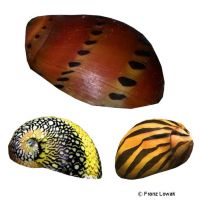Mosaic Nerite (Neritina sp. 'Mosaic')
| Mosaic Nerite Neritina sp. 'Mosaic' | |
|---|---|
| Name | Mosaic Nerite |
| Name Lat. | Neritina sp. 'Mosaic' |
| Family | Nerites |
| Family lat. | Neritidae |
| Order | Cycloneritids |
| Order lat. | Cycloneritida |
| Origin | Southeast Asia |
| Habitat | Streams, estuaries |
| Diet | Algae, detritus, snail food |
| pH | 7.0-8.5 |
| Behavior | Peaceful |
| Keeping | Group |
| Care Level | Easy |
| Reproduction | Marine larval stages |
| Breeding | None reported |
| Life Span | 4-6 years |
| Protection | No |
| Metric Units | |
| Size | 3.5 cm |
| Temperature | 20-27 °C |
| Hardness | 10-20 °dH |
| Aquarium | ~ 20 l |
| US Units | |
| Size | 1.4" |
| Temperature | 68-81 °F |
| Hardness | 178-356 ppm |
| Aquarium | ~ 5 gal |
Distribution and habitat
The mosaic racing snails are widespread in coastal areas from southeast Africa to southeast Asia and the Pacific islands. There they live in the freshwater areas of estuaries and in coastal streams. According to their origin, the pattern and coloration can vary greatly.
Maintenance
They need a well-structured aquarium with roots, stones and plants. The substrate of dark sand or gravel should be partially covered with foliage (e.g. sea almond leaves, oak leaves), rotting plant material and mulm
The water quality must be that required for average freshwater fish keeping. No ammonia, ammonium and nitrite should be detectable in the water and the nitrate value should be below 100 mg/l. When using a filter, make sure that only a weak current is created and that no animals can be sucked in. The lighting must correspond to the natural day-night rhythm of the animals.
Diet
They feed mainly on algae growth, which they graze from stones, roots, plants and furnishings, but also eat detritus (remains of dead plants and animals). For supplementation and in case of algae deficiency, algae leaves, over-broiled lettuce or sinking dry food for ornamental fish (granules, food tablets) with high vegetable content (spirulina) can be offered, which is usually accepted after habituation. Unaccepted food must be siphoned off after 2-3 hours
Regular and varied feeding promotes health and prevents deficiency symptoms.
Behaviour and compatibility
It is recommended to keep these snails in a group of 5-10 animals. They can be kept well in a nano aquarium. Also a socialization with fish, which do not regard snails as food, is well possible. Basically, only mutually compatible species with similar demands on water quality and water temperature should be socialized.
Reproduction and breeding
They are separately sexed. The sexes can hardly be distinguished from each other externally. The sexual organ of the male is located under the right antenna, but is usually not visible because of the close-fitting shell.
After mating, the female sticks egg capsules to various substrates. Each of these capsules contains numerous eggs from which swimmable larvae hatch and live for some time as part of the marine plankton in the sea. As they grow, they then form their shells, switch to a crawling lifestyle, and return to the estuaries
There are no known reports of successful breeding in the aquarium.
Important
To build up their shells, they need a sufficient supply of lime. Especially in soft, acidic water, damage to the shell (holes) can occur due to a lack of lime, which can lead to the death of the snail. Therefore, special attention should be paid to the calcium concentration in the water and, if necessary, calcium should be added in the form of limestone, cuttlebone or special preparations from the specialized trade
The foliage (sea almond tree, oak, beech, etc.) not only provides cover, but when rotting promotes the development of microorganisms, which are a valuable secondary food source.
The well-being of the animals should be monitored regularly. Temperature should be checked daily, pH, hardness and nitrate levels at least every 14 days. Regular partial water changes are recommended, even when contaminant levels have not yet reached the upper limit. Sudden changes in water quality should be avoided. Newly introduced animals must be accustomed slowly to the water in the aquarium.
Further literature can be found in your pet store.
References
Text: petdata; Image: Franz Lowak
Source: BITTER (2008): Schnecken-Fibel, Dähne Verlag; ENGELMANN & LANGE (2011): Zootierhaltung - Tiere in menschlicher Obhut: Wirbellose, Verlag Harri Deutsch
